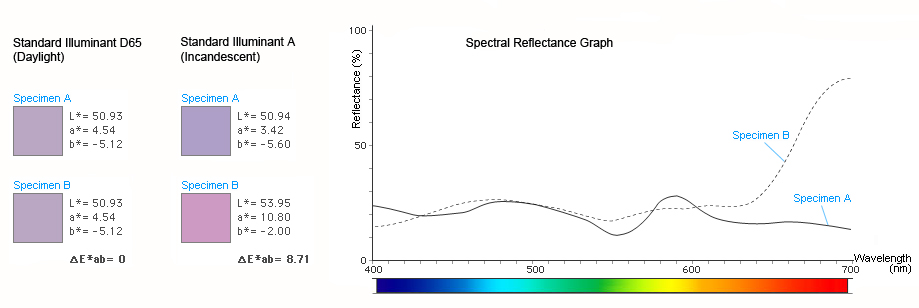Metamerism definition and why it matters
A couple of weeks ago, a co-worker came into the office only to realize that what had appeared to match earlier that morning when getting dressed, was actually two different shades of color. Her “brown” cardigan, worn to match her brown shirt, was actually a reddish color. Like many others, she was a victim of metamerism, a color phenomenon that, when under certain lighting, will show two objects matching in color. That is, until the differences in color are revealed when viewed under another light source, as illustrated in the cartoon image and exemplified by our co-worker’s mismatched outfit.
What Is Metamerism and Why Does It Occur?
Metamerism [muh-tam-uh-riz-uhm] describes a pair of objects that match under a certain light source or set of viewing conditions, but not under another. Our co-worker’s shirt and cardigan appeared to match in the incandescent lighting of her home, for example but did not match under the fluorescent lighting of our office. This is a common problem for textile manufacturers, often with clothing pieces not matching under certain lighting due to variations in textile dyes used during manufacturing.
Metamerism in textile manufacturing isn’t the only place where this is relevant, though. Companies in the paint, automotive, plastics, packaging, and print industries may have this issue because various pigments or color batches are sometimes changed when manufacturing or producing different parts of one product.
An auto body shop might paint a section of a car, such as a door, with a color that appears to match the rest of the vehicle when viewed in daylight, but doesn’t match when viewed under parking lot lighting. In other examples where metamerism occurs, plastic manufacturers working with specialized pigments may have issues with their product showing inconsistent color only when viewed at a certain angle, and print companies may find that ink on one print page may not match the ink on another page only when viewed under natural daylight and fluorescent lighting. To ensure metameric color matches, it is necessary to evaluate colors.
What is metameric match? How is this used for Color Consistency?
To identify metamerism, a spectrophotometer is used to measure and evaluate the metameric properties of the specimens under two or more different illuminants, such as daylight (Standard Illuminant D65) and incandescent (Standard Illuminant A). A spectrophotometer allows users to see the reflectance data of the two colors under each illuminant and is effective in identifying a mismatch. In the example below, we can see that two specimens (Specimen A and Specimen B) match under a daylight illuminant, but do not match under an incandescent illuminant.
When the spectral reflectance curves of two specimens cross over each other at least three times, as seen in the Spectral Reflectance Graph above, then the objects can be confirmed as a non-matching, metameric pair. To reduce the degree of metamerism, ideally, the same colorants that were used to create the standard sample should be used when formulating the color of a product. If this is not possible, and in most cases, it’s not, then a color formulation process should be implemented to find the least metameric colorant combination for each color batch. This will minimize the metamerism effect and produce a good match.
Metamerism can be a costly problem in manufacturing and production processes. When colors don’t match, they need to be reformulated or corrected. This not only impacts the satisfaction of customers, but can significantly impact the efficiency, lead time, and amount of rejects in a company’s operations. With the proper tools and color processes set in place, however, metamerism will be reduced and optimized.











